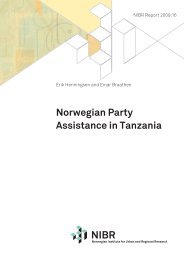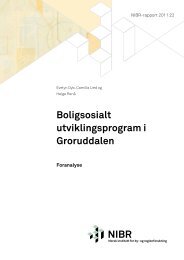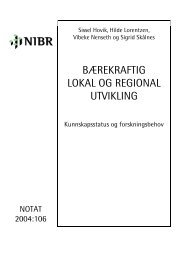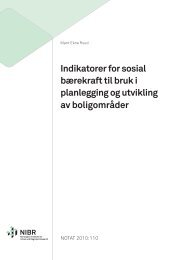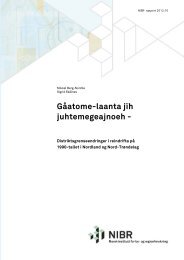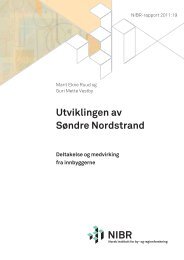http://www.tandfonline.com/page/terms-andconditions
The special importance of housing policy for ethnic minorities ...
The special importance of housing policy for ethnic minorities ...
- No tags were found...
Create successful ePaper yourself
Turn your PDF publications into a flip-book with our unique Google optimized e-Paper software.
International Journal of Housing Policy 9Downloaded by [Norsk Institutt for By og] at 07:07 11 March 2013acquisition of owner-occupied dwellings and cooperative housing. This, on the one hand,depends on price and rent levels on the housing market, on the other hand on housingsubsidies and finance systems. It is not an easy task to disentangle the effects of housingpolicy because prices and rents on the housing markets are affected by subsidies andfinance. Subsidies are thus to some extent passed on to the prices on the market. Moreover,the structure of subsidies not only influences access and the possibility of keeping adwelling, but also the kind of tenures that are produced. For example, high indirect taxsubsidies promote homeownership. Social/public housing requires the existence of specificsubsidies.Table 3 shows an evaluation of the differences in affordability for household with lowerin<strong>com</strong>es in the different tenures in the countries. The table is based on a detailed <strong>com</strong>parisonand evaluation of housing prices, rents and subsidy systems in four Nordic countries (SkifterAndersen, 2012). Below is a further argument for the judgements.Social/public housing in Denmark is in principle affordable for everyone. Also, in Finland,rent setting and subsidies make social/public housing affordable. The municipalities’autonomy in rent-setting principles for social/public housing in Norway has resulted inmarket prices in the metropolitan area (Medby & Langsether, 2007). To survive this rentpolicy, tenants are dependent on housing allowance, often <strong>com</strong>bined with social allowance.Rents, which are below market rents in the private renting sector in Denmark andSweden (only in the more urbanised areas), may make these dwellings more affordable.This is especially the case in Denmark, but rents are differentiated with very low rentsin part of the market and at the same time very high rents in others. Earlier lower priceson cooperatives in Denmark made them more affordable, but in recent years prices haveincreased to market levels in parts of the stock.Affordability in owner-occupied housing depends on property prices, finance systems,tax support and supply support. Subsidies and state guaranties for loansmake it easier for first time buyers and low-in<strong>com</strong>e groups to acquire a home inNorway, Finland and Sweden. Low-in<strong>com</strong>e homeowners in Norway also benefit fromhousing allowance. However, new research documents that twice as many of the immigrantpopulation have debts three times their yearly in<strong>com</strong>e, <strong>com</strong>pared with the whole population(Ellingsen, 2011). Combined with the fact that immigrants in Norway have a large shareof ownership, the high rate of borrowing can be interpreted as indicating that the lack ofrental housing and difficult conditions for immigrants on the rental market, have resultedin some immigrants with lower in<strong>com</strong>es being pushed to enter the owner occupied marketin order to get a satisfactory home.Table 3. Comparison between four Nordic countries regarding the affordability of low-in<strong>com</strong>egroups in different tenures.Denmark Finland Norway SwedenTenureSocial housing +++ +++ ++ +++Private renting ++ ++ + ++Cooperatives, etc. +++ ++ ++Owner-occupied + + + ++Most affordable: +++Least affordable: +



